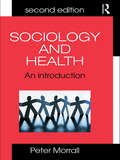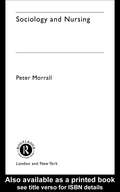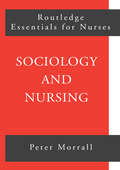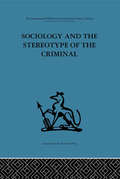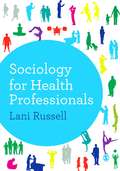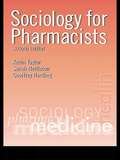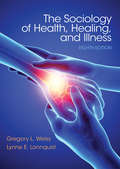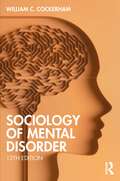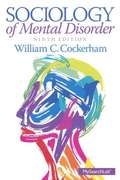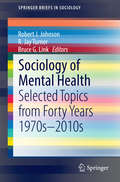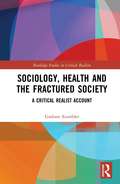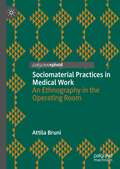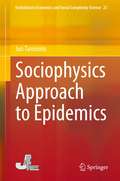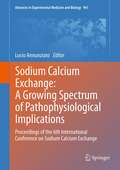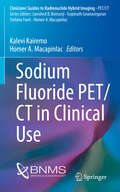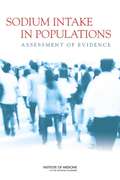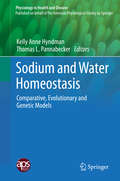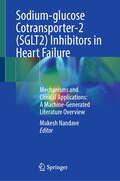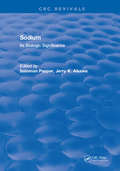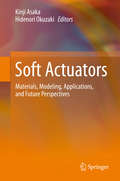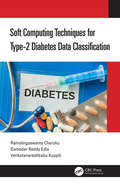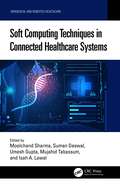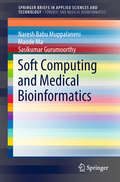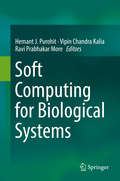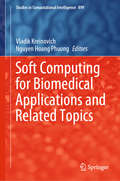- Table View
- List View
Sociology and Health: An Introduction
by Peter MorrallThis lively, introductory text provides students and health practitioners with the foundations of a sociological understanding of health issues. Written for anyone who is interested in health and disease in contemporary global society, this book engages the reader to act upon their occupational and moral responsibilities. It explains the key sociological theories and debates with humour and imagination in a way that will encourage an inquisitive and reflective approach on the part of any student who engages with the text. With individual chapters covering sociology, health, science, power, medicalisation, madness happiness, sex, violence and death, Sociology and Health is organized so that the student moves through sociological approaches and themes which constantly recur in the experience of healthcare. Students will find this a readable and controversial text which covers the ground they need to know in a thought-provoking way. Lecturers will find it a helpful text for generating discussion in tutorials and seminars. There are summaries at the end of each chapter, suggestions for further reading and ideas for the reader.
Sociology and Nursing: An Introduction (Routledge Essentials For Nurses Ser.)
by Peter MorrallThis introductory text provides nurses with the foundations of a sociological understanding of health issues which they should find of great help in thinking about their work and the role of their profession. It explains the key sociological theories and debates with humour and imagination in a way which will encourage an inquisitive and reflective approach on the part of any student who engages with the text.
Sociology and Nursing: An Introduction (Routledge Essentials For Nurses Ser.)
by Peter MorrallThis introductory text provides nurses with the foundations of a sociological understanding of health issues which they should find of great help in thinking about their work and the role of their profession. It explains the key sociological theories and debates with humour and imagination in a way which will encourage an inquisitive and reflective approach on the part of any student who engages with the text.
Sociology and the Stereotype of the Criminal
by Dennis ChapmanTavistock Press was established as a co-operative venture between the Tavistock Institute and Routledge & Kegan Paul (RKP) in the 1950s to produce a series of major contributions across the social sciences. This volume is part of a 2001 reissue of a selection of those important works which have since gone out of print, or are difficult to locate. Published by Routledge, 112 volumes in total are being brought together under the name The International Behavioural and Social Sciences Library: Classics from the Tavistock Press. Reproduced here in facsimile, this volume was originally published in 1968 and is available individually. The collection is also available in a number of themed mini-sets of between 5 and 13 volumes, or as a complete collection.
Sociology for Health Professionals
by Dr Lani RussellSociology is a key topic for all trainee health professionals, but many struggle to see what sociology has to offer. Based on years of experience teaching sociology to healthcare students, Lani Russell has written a truly introductory text which explains the main sociological concepts without jargon or becoming too advanced. Using carefully chosen examples, she shows how health issues are influenced by social phenomena such as class, race or sexuality and the relevance this has for practitioners. The book includes: -The main sociological concepts relevant to healthcare students -Examples linking sociological concepts and major health topics -Exercises to test students' understanding -Glossaries of key terms and key theorists -Advice on further reading -A full companion website with teaching materials for lecturers and learning resources for students This is the ideal text to recommend to students who need an accessible introduction to the sociology of health and illness.
Sociology for Pharmacists: An Introduction
by Sarah Nettleton Geoffrey Harding Kevin M. TaylorSociology for Pharmacists: An Introduction is written specifically for professionals and students in pharmacy who are newcomers to the study of sociology. It introduces the key concepts of sociology and demonstrates their importance and application to pharmacy practice in the 21st century. It is unique in its role as the only text to introduce sociology specifically to pharmacists. Rather than an exhaustive treatment, the book provides a concise introduction to major perspectives in sociology-drawing on research evidence pertaining to health, illness, and professional practice-which will inform and enhance pharmacy practice. It offers an overview of sociology for rather than sociology of pharmacy, and will both inform practitioners and stimulate informed research into the social aspects of pharmacy practice.Key issues covered include:Key sociological concepts and perspectives Contemporary developments in pharmacy practice and pharmacy's professional statusA review of research into the way people react to illness and look after their healthHow and why illness and disease are influenced by gender, ethnicity, and social class Health education and pharmacists' role in promoting health and ensuring appropriate medicine usageSocial research methodsPharmacists are frequently encouraged to broaden their day-to-day practice. This timely book does just that by encouraging pharmacists to become more involved with advising clients, managing medicines, and supporting the promotion of health. In addition to providing an overview of these topics, the book also reviews the relevant research, and directs readers to further information.
Sociology of Health, Healing, and Illness
by Gregroy L. Weiss Lynne E. LonnquistA comprehensive presentation of the major topics in medical sociology. The Sociology of Health, Healing, and Illness, 8/e by Gregory L. Weiss and Lynne E. Lonnquist provides an in-depth overview of the field of medical sociology. The authors provide solid coverage of traditional topics while providing significant coverage of current issues related to health, healing, and illness. Readers will emerge with an understanding of the health care system in the United States as well as the changes that are taking place with the implementation of The Affordable Care Act.
Sociology of Mental Disorder
by William C. CockerhamThe twelfth edition of the Sociology of Mental Disorder presents the major issues and research findings on the influence of race, social class, gender, and age on the incidence and prevalence of mental disorders. The text also examines the institutions that help those with mental disorders, mental health law, and public policy. Many important updates are new to this edition: The mental health effects of the COVID-19 pandemic are examined. Aging and mental health is discussed in more detail. Updated review of gender differences in mental disorder. A revised and more in-depth discussion of mental health and race. Problems in the community care of the mentally ill are covered. Updates of research and citations throughout. Blending foundational concepts and sociological perspectives on mental health issues with newer studies and accounts in an accessible and authoritative survey of the field, the new edition of Sociology of Mental Disorder remains an essential text and an invaluable resource for students and scholars.
Sociology of Mental Disorder (9th Edition)
by William C. CockerhamThis edition of book is includes the most recent literature and research on mental disorder including topics like DSM-5, examining socio-demographic factors, assessment of differences between male-female psychological distress etc.
Sociology of Mental Health
by Robert J. Johnson R. Jay Turner Bruce G. LinkThis volume provides an overview of mental health research conducted by sociologists. It discusses dominant themes such as stress, the community and mental life, family structure, social relations and recovery. The unique contribution of sociology to the study of mental health has a long history stretching from the very foundations of modern sociology. Yet it was only twenty years ago that the Section on Sociology of Mental Health of the American Sociological Association was formed largely in response to a burgeoning rise in the sum and significance of research in the field. Today the section is a large and vibrant one with its own journal, Society and Mental Health. This book explores several of the themes that have occurred during that period, providing both perspectives of the past and prospects for the future. The volume is timely, following closely the 20th anniversary of the section's formation. Its coverage of key issues and its advancement of the scholarly debates on these issues will prove valuable to students and senior scholars alike.
Sociology, Health and the Fractured Society: A Critical Realist Account (Routledge Studies in Critical Realism)
by Graham ScamblerIt is now accepted that many of the determinants of health and health care are social. This volume offers a philosophical and theoretical frame within which the nature and extent of this might be optimally examined. The analysis is rooted in Roy Bhaskar’s basic and dialectical critical realism, although it draws also on the critical theory of Jurgen Habermas. It purports to provide an ontologically and epistemologically grounded comparative sociology of contemporary health and health care in the twenty-first century. Carrying a fourfold agenda, the volume sets out a dialectical critical realist frame for a comparative sociology of health and health care; it clarifies sociology’s potential and limitations; it suggests a research programme and a series of questions for investigation; and it offers an argument for an action sociology embedded in a dialectical theory of transformative action. This volume will be of interest to students and scholars in the areas of philosophy, sociology and critical realism, as well as those working in health and social care.
Sociomaterial Practices in Medical Work: An Ethnography in the Operating Room
by Attila BruniThis book presents a sociomaterial perspective on work and organizational practices within the operating room. Looking at medical work from a sociological perspective and drawing on ethnographic observations conducted in a hospital's operating block, this book analyses the entanglements of humans and technologies in the execution of everyday activities. It highlights how the sociomateriality of work and organizational practices manifests in the encounters between operators and material artifacts and in the way objects and technologies participate in processes and practices of organizational communication. Objects and technologies are also shaped by these very practices, giving rise to a recursive relationship wherein technology, communication, and organizing are intertwined.A sociomaterial understanding of organizational and working practices explains the role of objects and technologies in the generation and enactment of professional knowledge, while questioning how power materializes through the interaction of humans and technical objects. This book will be of great interest to scholars, students, and practitioners interested in how sociomaterial perspectives can inform organization studies and reshape our understanding of the intricate relationships between humans and technologies in healthcare settings.
Sociophysics Approach to Epidemics (Evolutionary Economics and Social Complexity Science #23)
by Jun TanimotoThis book presents the fundamentals of evolutionary game theory and applies them to the analysis of epidemics, which is of paramount importance in the aftermath of the worldwide COVID-19 pandemic. The primary objective of this monograph is to deliver a powerful tool to model and analyze the spread of an infectious disease during a pandemic as well as the human decision dynamics. The book employs a variant of the “vaccination game,” in which a mathematical epidemiological model dovetails with evolutionary game theory. From a social physics standpoint, this book introduces an extended concept of the vaccination game starting from the fundamental issues and touching on the newest practical applications.The book first outlines the fundamental basis of evolutionary game theory, in which a two-player and two-strategy game, the so-called 2 × 2 game, and a multi-player game are concisely introduced, and the important issue of how social dilemmas are quantified is highlighted. Subsequently, the book discusses various recent applications of the extended concept of the vaccination game so as to quantitatively evaluate provisions other than vaccination, including practical intermediate protective measures such as mask-wearing, efficiency of quarantine compared with that of isolation policies for suppressing epidemics, efficiency of preemptive versus late vaccination, and optimal subsidy policies for vaccination.
Sodium Calcium Exchange: A Growing Spectrum of Pathophysiological Implications
by Lucio AnnunziatoThis book reports the text of the lectures of the 6th International Conference on Sodium Calcium Exchange held in Lacco Ameno in the Island of Ischia in the Gulf of Naples, Italy, from October 1 to October 5, 2011. The present book uncovers the most striking new findings on NCX that emerged since the previous Conference on Sodium Calcium Exchange, such as the structural dissection of the molecular determinants of Ca2+ sensitivity of the exchanger, the epigenetic regulation of ncx1 gene, the molecular identification of the mitochondrial Sodium Calcium Exchanger, and the discovery of NCX in unexpected anatomical locations such as the female reproductive tract. The book is organized into 11 parts covering NCX structural aspects, genetic and epigenetic regulation, regulatory mechanisms, subcellular localization in mitochondria, involvement in neurodegenerative diseases and in immune regulation, and the role of the cardiovascular and endocrine systems, as well as diabetes in physiology and pathophysiology. Selected chapters of the book are also devoted to the interaction of NCKX and other ion channels and transporters with NCX, like ASICs, TRPM, and NHE.
Sodium Fluoride PET/CT in Clinical Use (Clinicians’ Guides to Radionuclide Hybrid Imaging)
by Kalevi Kairemo Homer A. MacapinlacThis pocket book is the first of its kind on sodium fluoride (18F-NaF)-PET and addresses skeletal as well as cardiovascular applications. In malignant metastatic diseases 18F-NaF-PET has already demonstrated its benefits in cancer staging, re-staging, follow-up and response evaluation. It also has an emerging diagnostic role in the calcified soft-tissue metastases of primary bone tumours, and can be applied to evaluate cardiovascular diseases, such as calcifications in heart valves and peripheral vascular disease. The book is divided into 11 chapters: five on oncology, four addressing the general aspects of skeletal conditions, and two on cardiovascular diseases. It offers a valuable guide for referring colleagues, nuclear medicine physicians/radiologists and aid clinicians, and highlights the main applications and limitations of 18F-NaF-PET hybrid imaging (PET/CT).
Sodium Intake in Populations
by Institute of Medicine Brian L. Strom Board on Population Health and Public Health Practice Food and Nutrition Board Maria Oria Ann L. Yaktine Committee on the Consequences of Sodium Reduction in PopulationsDespite efforts over the past several decades to reduce sodium intake in the United States, adults still consume an average of 3,400 mg of sodium every day. A number of scientific bodies and professional health organizations, including the American Heart Association, the American Medical Association, and the American Public Health Association, support reducing dietary sodium intake. These organizations support a common goal to reduce daily sodium intake to less than 2,300 milligrams and further reduce intake to 1,500 mg among persons who are 51 years of age and older and those of any age who are African-American or have hypertension, diabetes, or chronic kidney disease. A substantial body of evidence supports these efforts to reduce sodium intake. This evidence links excessive dietary sodium to high blood pressure, a surrogate marker for cardiovascular disease (CVD), stroke, and cardiac-related mortality. However, concerns have been raised that a low sodium intake may adversely affect certain risk factors, including blood lipids and insulin resistance, and thus potentially increase risk of heart disease and stroke. In fact, several recent reports have challenged sodium reduction in the population as a strategy to reduce this risk. Sodium Intake in Populations recognizes the limitations of the available evidence, and explains that there is no consistent evidence to support an association between sodium intake and either a beneficial or adverse effect on most direct health outcomes other than some CVD outcomes (including stroke and CVD mortality) and all-cause mortality. Some evidence suggested that decreasing sodium intake could possibly reduce the risk of gastric cancer. However, the evidence was too limited to conclude the converse--that higher sodium intake could possibly increase the risk of gastric cancer. Interpreting these findings was particularly challenging because most studies were conducted outside the United States in populations consuming much higher levels of sodium than those consumed in this country. Sodium Intake in Populations is a summary of the findings and conclusions on evidence for associations between sodium intake and risk of CVD-related events and mortality.
Sodium and Water Homeostasis
by Kelly Anne Hyndman Thomas L. PannabeckerThis book presents cutting edge methods that provide insights into the pathways by which salt and water traverse cell membranes and flow in an orchestrated fashion amongst the many compartments of the body. It focuses on a number of molecular, cellular and whole animal studies that involve multiple physiological systems and shows how the internal milieu is regulated by multifactorial gene regulation, molecular signaling, and cell and organ architecture. Topics covered include: water channels, the urinary concentrating mechanism, angiotensin, the endothelin system, miRNAs and MicroRNA in osmoregulation, desert-adapted mammals, the giraffe kidney, mosquito Malpighian tubules, and circadian rhythms. The book highlights how different approaches to explaining the same physiological processes greatly increase our understanding of these fundamental processes. Greater integration of comparative, evolutionary and genetic animal models in basic science and medical science will improve our overall grasp of the mechanisms of sodium and water balance.
Sodium-glucose Cotransporter-2 (SGLT2) Inhibitors in Heart Failure: Mechanisms and Clinical Applications: A Machine-Generated Literature Overview
by Mukesh NandaveThe book delves into the development and therapeutic potential of Sodium-glucose Cotransporter-2 (SGLT2) inhibitors for the treatment of diabetes and cardiovascular diseases. It explores their mechanism of action, cardiovascular benefits, and role in primary and secondary protection from renal and cardiovascular diseases. The book also highlights their emerging opportunities in the management of myocardial infarction, diabetic cardiomyopathy, and congestive heart failure. It provides a comprehensive review of preclinical and clinical information on the cardiovascular advantages of SGLT2 inhibitors. Additionally, the book explores selective drugs and their effects on cardiovascular events, mortality, and safety outcomes in individuals with type 2 diabetes. The book is a valuable resource for researchers, healthcare professionals, and individuals interested in the field of SGLT2 inhibitors and their impact on diabetes and cardiovascular health.
Sodium: Its Biologic Significance
by PapperSodium is concerned with the physiology, pathophysiology, and clinical consequences of altered physiology involving the sodium ion.The first section focuses on the presence and handling of sodium in the normal state. In chapter one, Drs. Solomon and Galey deal with the fundamentals of transport and energy metabolism as they relate to sodium. This is followed by a chapter in which Drs. Gardenswartz and Schrier consider in detail the normal body economy of sodium, and especially the factors (particularly extracellular fluid volume) that regulate the renal handling of sodium and the responses of the various portions of the nephron to these influences.
Soft Actuators
by Kinji Asaka Hidenori OkuzakiThe subject of this book is the current comprehensive research and development of soft actuators, and encompasses interdisciplinary studies of materials science, mechanics, electronics, robotics and bioscience. As an example, the book includes current research on actuators based on biomaterials to provide future perspectives for artificial muscle technology. Readers can obtain detailed, useful information about materials, methods of synthesis, fabrication and measurements. The topics covered here not only promote further research and development of soft actuators but also lead the way to their utilization and industrialization. One outstanding feature of the book is that it contains many color figures, diagrams and photographs clearly describing the mechanism, apparatus and motion of soft actuators. The chapter on modeling is conducive to more extensive design work in materials and devices and is especially useful in the development of practical applications. Readers can acquire the newest technology and information about the basic science and practical applications of flexible, lightweight and noiseless soft actuators, which are quite unlike conventional mechanical engines and electric motors. The new ideas offered in this volume will provide inspiration and encouragement to researchers and developers as they explore new fields of applications for soft actuators.
Soft Computing Techniques for Type-2 Diabetes Data Classification
by Damodar Reddy Edla Venkatanareshbabu Kuppili Ramalingaswamy CherukuDiabetes Mellitus (DM, commonly referred to as diabetes, is a metabolic disorder in which there are high blood sugar levels over a prolonged period. Lack of sufficient insulin causes presence of excess sugar levels in the blood. As a result the glucose levels in diabetic patients are more than normal ones. It has symptoms like frequent urination, increased hunger, increase thirst and high blood sugar. There are mainly three types of diabetes namely type-1, type-2 and gestational diabetes. Type-1 DM occurs due to immune system mistakenly attacks and destroys the beta-cells and Type-2 DM occurs due to insulin resistance. Gestational DM occurs in women during pregnancy due to insulin blocking by pregnancy harmones. Among these three types of DM, type-2 DM is more prevalence, and impacting so many millions of people across the world. Classification and predictive systems are actually reliable in the health care sector to explore hidden patterns in the patients data. These systems aid, medical professionals to enhance their diagnosis, prognosis along with remedy organizing techniques. The less percentage of improvement in classifier predictive accuracy is very important for medical diagnosis purposes where mistakes can cause a lot of damage to patient’s life. Hence, we need a more accurate classification system for prediction of type-2 DM. Although, most of the above classification algorithms are efficient, they failed to provide good accuracy with low computational cost. In this book, we proposed various classification algorithms using soft computing techniques like Neural Networks (NNs), Fuzzy Systems (FS) and Swarm Intelligence (SI). The experimental results demonstrate that these algorithms are able to produce high classification accuracy at less computational cost. The contributions presented in this book shall attempt to address the following objectives using soft computing approaches for identification of diabetes mellitus. Introuducing an optimized RBFN model called Opt-RBFN. Designing a cost effective rule miner called SM-RuleMiner for type-2 diabetes diagnosis. Generating more interpretable fuzzy rules for accurate diagnosis of type2 diabetes using RST-BatMiner. Developing accurate cascade ensemble frameworks called Diabetes-Network for type-2 diabetes diagnosis. Proposing a Multi-level ensemble framework called Dia-Net for improving the classification accuracy of type-2 diabetes diagnosis. Designing an Intelligent Diabetes Risk score Model called Intelli-DRM estimate the severity of Diabetes mellitus. This book serves as a reference book for scientific investigators who need to analyze disease data and/or numerical data, as well as researchers developing methodology in soft computing field. It may also be used as a textbook for a graduate and post graduate level course in machine learning or soft computing.
Soft Computing Techniques in Connected Healthcare Systems (Biomedical and Robotics Healthcare)
by Umesh Gupta Moolchand Sharma Mujahid Tabassum Suman Deswal Isah A. LawalThis book provides an examination of applications of soft computing techniques related to healthcare systems and can be used as a reference guide for assessing the roles of various techniques. Soft Computing Techniques in Connected Healthcare Systems presents soft computing techniques and applications used in healthcare systems, along with the latest advancements. The authors examine how connected healthcare is the essence of combining a practical operative procedure of interconnectedness of electronic health records, mHealth, clinical informatics, electronic data exchange, practice management solutions, and pharmacy management. The book focuses on different soft computing techniques, such as fuzzy logic, ANN, and GA, which will enhance services in connected health systems, such as remote diagnosis and monitoring, medication monitoring devices, identifying and treating the underlying causes of disorders and diseases, improved access to specialists, and lower healthcare costs. The chapters also examine descriptive, predictive, and social network techniques and discuss analytical tools and the important role they play in enhancing the services to connected healthcare systems. Finally, the authors address real-time challenges with real-world case studies to enhance the comprehension of topics. This book is intended for under graduate and graduate students, researchers, and practicing professionals in the field of connected healthcare. It provides an overview for beginners while also addressing professionals in the industry on the importance of soft computing approaches in connected healthcare systems.
Soft Computing and Medical Bioinformatics (SpringerBriefs in Applied Sciences and Technology)
by Naresh Babu Muppalaneni Maode Ma Sasikumar GurumoorthyThis book highlights the applications of soft computing techniques in medical bioinformatics. It reflects the state-of-the-art research in soft computing and bioinformatics, including theory, algorithms, numerical simulations, and error and uncertainty analysis. It also deals with novel applications of new processing techniques in computer science. This book is useful to both students and researchers from computer science and engineering fields.
Soft Computing for Biological Systems
by Vipin Chandra Kalia Hemant J. Purohit Ravi Prabhakar MoreThis book explains how the biological systems and their functions are driven by genetic information stored in the DNA, and their expression driven by different factors. The soft computing approach recognizes the different patterns in DNA sequence and try to assign the biological relevance with available information.The book also focuses on using the soft-computing approach to predict protein-protein interactions, gene expression and networks. The insights from these studies can be used in metagenomic data analysis and predicting artificial neural networks.
Soft Computing for Biomedical Applications and Related Topics (Studies in Computational Intelligence #899)
by Vladik Kreinovich Nguyen Hoang PhuongThis book presents innovative intelligent techniques, with an emphasis on their biomedical applications. Although many medical doctors are willing to share their knowledge – e.g. by incorporating it in computer-based advisory systems that can benefit other doctors – this knowledge is often expressed using imprecise (fuzzy) words from natural language such as “small,” which are difficult for computers to process. Accordingly, we need fuzzy techniques to handle such words. It is also desirable to extract general recommendations from the records of medical doctors’ decisions – by using machine learning techniques such as neural networks. The book describes state-of-the-art fuzzy, neural, and other techniques, especially those that are now being used, or potentially could be used, in biomedical applications. Accordingly, it will benefit all researchers and students interested in the latest developments, as well as practitioners who want to learn about new techniques.
